Green tea rice transforms ordinary steamed rice into an aromatic and visually stunning dish that’s become a beloved staple in Japanese cuisine. This matcha-infused rice delivers a subtle earthy flavor and beautiful pale green color that’ll elevate any meal from simple to sophisticated.
We love how this recipe combines the health benefits of green tea with the comforting simplicity of perfectly cooked rice. The antioxidants from matcha powder not only add nutritional value but also create a unique taste profile that pairs beautifully with both traditional Japanese dishes and modern fusion cuisine.
What makes this green tea rice so special is its versatility – it works as an elegant side dish for dinner parties or as a daily staple that adds excitement to your regular meal rotation. The preparation is surprisingly simple and takes just as long as cooking regular rice.
Ingredients
Creating this aromatic green tea rice requires just a few simple ingredients that combine to deliver remarkable flavor. We’ve organized our ingredients into two categories to help you prepare this elegant dish with ease.
For the Green Tea Rice
- 2 cups short-grain white rice (sushi rice preferred)
- 2 tablespoons matcha powder (culinary grade)
- 2¼ cups water
- 1 teaspoon salt
- 1 tablespoon unsalted butter (optional)
- 1 tablespoon mirin (optional for subtle sweetness)
For Optional Toppings
- 2 tablespoons toasted sesame seeds
- 1 sheet nori seaweed (cut into thin strips)
- 2 green onions (finely chopped)
- 1 tablespoon furikake seasoning
- ½ cup edamame (shelled and cooked)
- 1 tablespoon pickled ginger (julienned)
- Fresh cilantro leaves for garnish
Equipment Needed
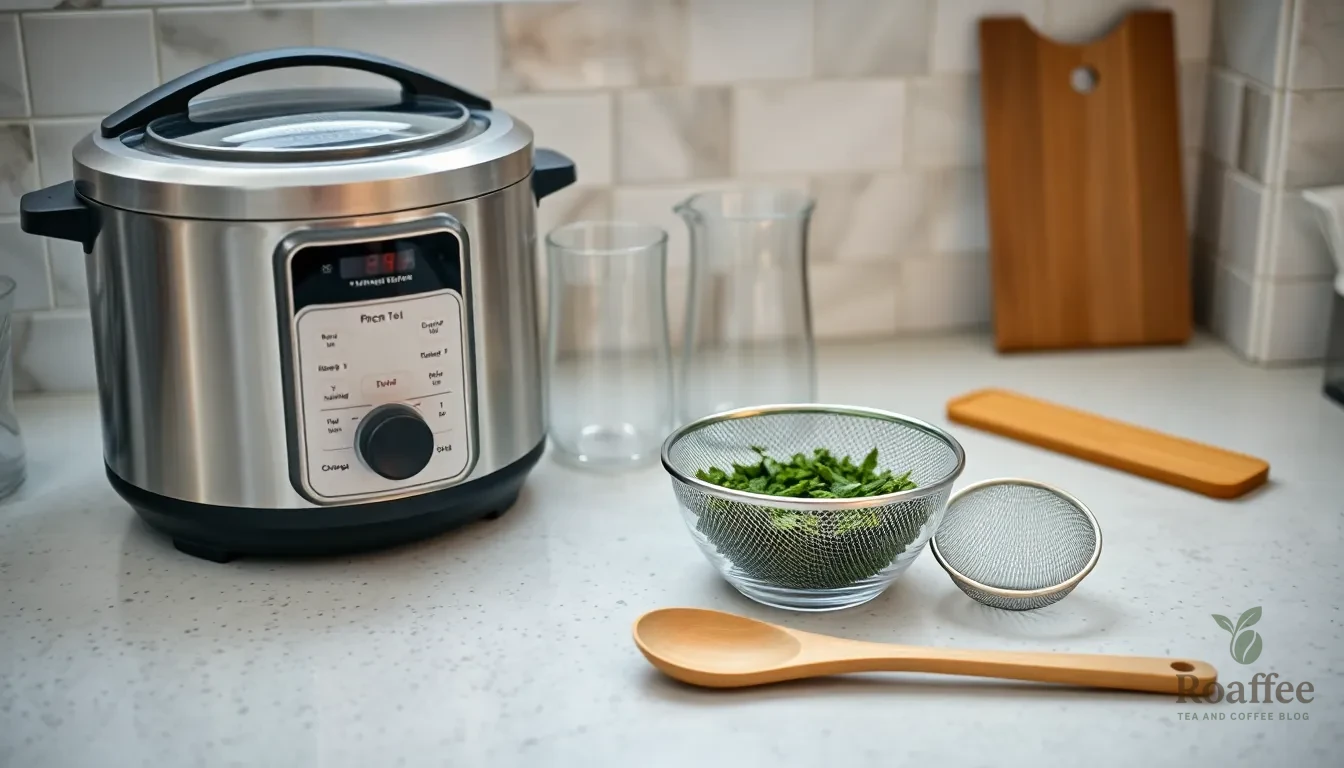
Creating our flavorful green tea rice requires minimal kitchen equipment that most home cooks already possess. We recommend gathering these essential tools before beginning our preparation process.
Rice Cooker serves as our primary cooking vessel for achieving perfectly cooked rice with consistent results. Standard rice cookers work excellently for this recipe, though we can also use a heavy-bottomed pot with a tight-fitting lid for stovetop cooking.
Measuring Cups ensure accurate proportions of rice and liquid ingredients. We need both dry measuring cups for rice and liquid measuring cups for water and any additional seasonings.
Small Bowl or Cup allows us to properly soak our green tea leaves with salt and water or sesame oil. This soaking process softens the leaves and creates the flavor base for our dish.
Fine-Mesh Strainer becomes essential when using the alternate brewing method. We use this tool to strain brewed green tea liquid before incorporating it into our rice cooking process.
Wooden Spoon or Rice Paddle helps us gently mix the softened tea leaves into our hot rice without breaking the delicate grains. These utensils prevent scratching non-stick surfaces while ensuring even distribution.
Optional Equipment includes a microwave for softening scallions if we choose to add them as garnish. We may also want measuring spoons for precise amounts of salt and sesame oil.
The beauty of this recipe lies in its simplicity. Most households already contain these basic cooking tools, making green tea rice an accessible dish for cooks of all experience levels. We can prepare this aromatic rice using standard kitchen equipment without investing in specialized gadgets.
Instructions
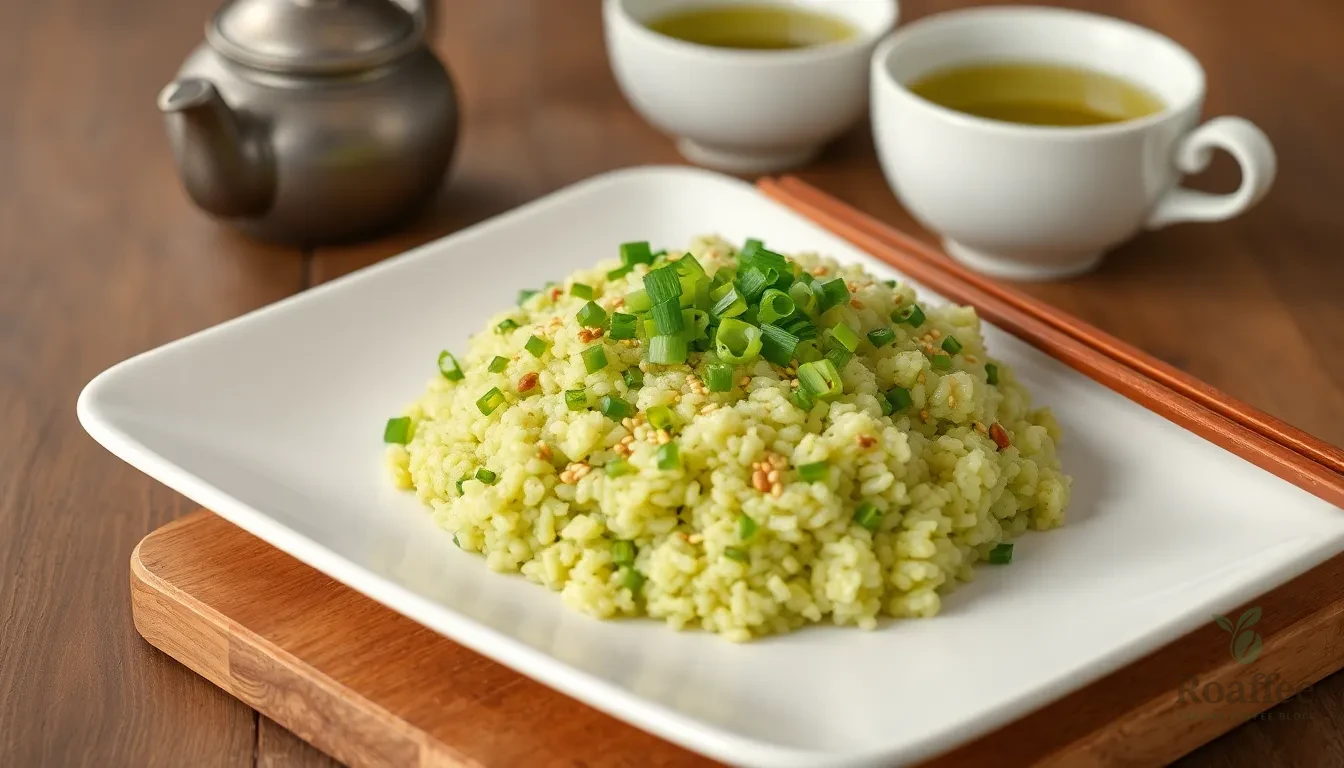
We’ll walk through this simple process that transforms ordinary rice into an aromatic green tea infused dish. Our method ensures perfectly cooked rice with a subtle tea flavor that pairs beautifully with any meal.
Prep the Green Tea
Begin by boiling 2 cups of water in a medium saucepan. Add 2 teaspoons of green tea leaves once the water reaches a rolling boil. Steep the tea for 4 to 10 minutes depending on how strong you prefer the flavor. We recommend starting with 4 minutes for a milder taste and adjusting in future batches.
Strain out all tea leaves using a fine mesh strainer to obtain clear brewed green tea. Set the strained tea aside and allow it to cool slightly while you prepare the rice. For those who prefer an even gentler flavor, steep the tea leaves in cold water for about an hour instead.
Prepare the Rice
Measure 1 cup of rice using white basmati, jasmine, or sushi rice for best results. Rinse the rice thoroughly under cold running water until the water runs completely clear. This step removes excess starch and prevents the rice from becoming sticky.
Add the rinsed rice to your cooking pot or rice cooker. Pour in the brewed green tea instead of plain water as your cooking liquid. Sprinkle in 1/4 to 1 teaspoon of salt according to your taste preference. We suggest adding 1 teaspoon of olive oil or sesame oil for extra richness and to prevent sticking.
Cook the Green Tea Rice
Bring the rice and green tea mixture to a rolling boil over medium high heat. Once boiling, immediately cover the pot with a tight fitting lid and reduce heat to low. Allow the rice to simmer gently for 15 to 20 minutes until all liquid is absorbed and the rice becomes tender.
Remove the pot from heat and let it stand covered for 5 minutes to complete the steaming process. Avoid lifting the lid during cooking as this releases essential steam. Rice cooker users can simply combine the rinsed rice and brewed green tea then cook using the standard rice setting.
Final Assembly
Fluff the cooked green tea rice gently with a fork or rice paddle to separate the grains. Taste and adjust seasoning with additional salt if needed. Serve the rice hot as an elegant side dish garnished with chopped scallions and toasted sesame seeds for extra flavor and visual appeal.
For a more substantial dish, transform your green tea rice into fried rice by cooling it completely first. Heat sesame oil in a large skillet and sauté diced vegetables like peas, carrots, and onions until tender. Add garlic powder, soy sauce, salt, and pepper to taste. Stir in the cooled green tea rice and sauté until heated through, stirring frequently to prevent sticking.
Cooking Tips and Techniques
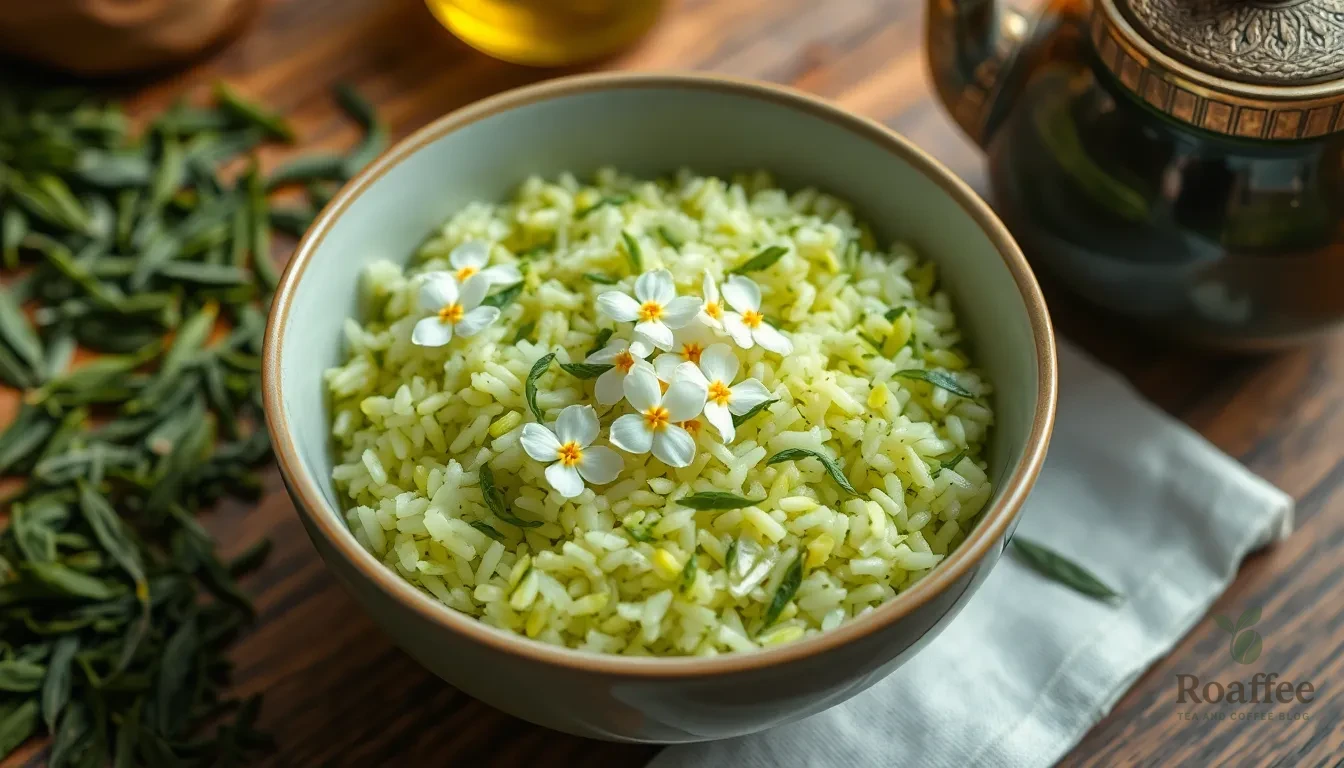
Mastering green tea rice requires understanding the delicate balance between tea selection and rice preparation. We’ve discovered that attention to these key details transforms ordinary rice into an extraordinary dish with perfect texture and flavor.
Choosing the Right Tea
We recommend using loose leaf green tea over powdered matcha or tea bags for this recipe because it brews a clearer and purer flavor. Loose leaf tea creates the ideal infusion without overpowering the rice’s natural taste.
Shincha stands out as our preferred choice for green tea rice. This early harvest tea offers the most balanced aroma and taste profile. We find that its delicate character complements rice perfectly without creating bitterness.
Cold steeping provides another excellent technique for tea preparation. We soak tea leaves in water for one hour to yield a mild infusion that’s ideal for cooking rice. This method eliminates any harsh or bitter notes that might develop with hot brewing.
We avoid using powdered green teas in this recipe because they can alter the rice texture negatively. The powder tends to create an uneven distribution and muddy appearance that detracts from the final dish.
| Tea Selection Guidelines | Best Choice | Why It Works |
|---|---|---|
| Tea Type | Loose leaf green tea | Creates clearer, purer flavor |
| Preferred Variety | Shincha (early harvest) | Balanced aroma and taste |
| Brewing Method | Cold steeping for 1 hour | Mild infusion without bitterness |
| Tea to Avoid | Powdered varieties | Can alter texture negatively |
Rice Texture Tips
Short-grain or jasmine rice delivers the best results for green tea rice. Short-grain rice provides the stickier texture that’s perfect for shaping and garnishing. Jasmine rice contributes a fragrant aroma that beautifully complements the tea flavors.
We always soak rice before cooking to improve softness and ensure even cooking. This step becomes especially important when preparing roasted rice for Genmaicha-style variations. The soaking process helps each grain cook uniformly.
Medium heat proves essential when cooking green tea rice. We maintain consistent heat levels and stir frequently to prevent burning while ensuring even flavor distribution throughout the dish. This careful temperature control preserves the delicate tea essence.
Cold rice becomes crucial when making fried green tea rice. We use rice that’s been refrigerated because it stays dry and prevents clumping. This technique allows for better frying texture and creates the desirable dry and slightly toasted finish.
We add salt during cooking because it balances the rice and tea flavors perfectly. Without salt the result tastes bland or overly floral. The salt enhances both components while creating harmony between them.
Serving Suggestions
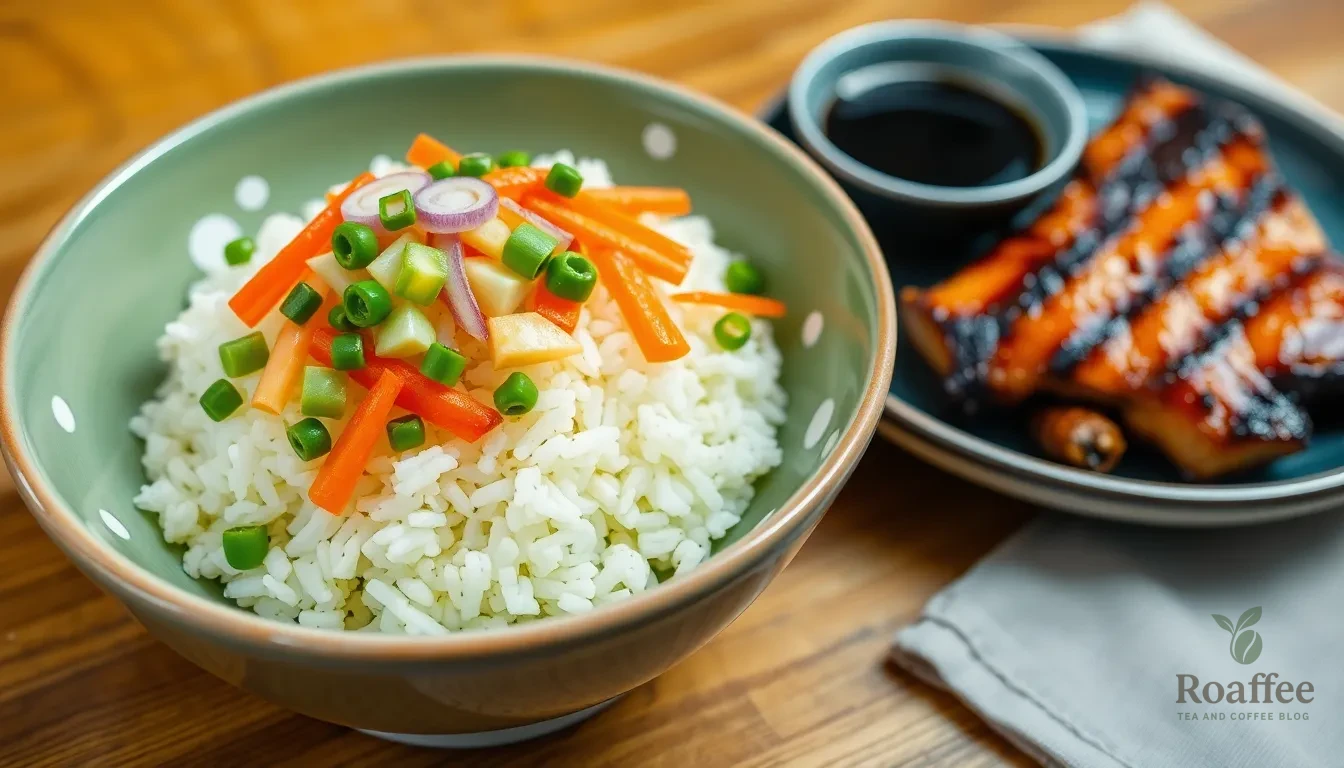
Green tea rice transforms into a versatile canvas for countless flavor combinations and presentation styles. We recommend serving this aromatic dish alongside grilled proteins like teriyaki chicken or miso-glazed salmon to create a balanced Japanese-inspired meal. The subtle tea flavor complements seafood beautifully, making it an excellent pairing with sushi rolls or sashimi platters.
For a traditional approach, we suggest creating ochazuke, a comforting Japanese tea rice soup that showcases the dish’s heritage. Simply ladle warm green tea broth over your cooked rice and top with shiitake mushrooms, sliced carrots, roasted nori seaweed, sesame seeds, and a splash of soy sauce. This warming preparation transforms simple rice into a satisfying light meal that takes approximately 30 minutes from start to finish.
We love preparing fried green tea rice as a more substantial option that utilizes leftover rice perfectly. Sauté fresh vegetables like peas, carrots, and onions in sesame oil with garlic powder, then add cooled green tea rice and toss with soy sauce. This variation creates a complete meal that incorporates the antioxidant benefits of green tea while delivering satisfying textures and flavors.
Creative topping combinations elevate our green tea rice beyond basic preparations:
- Protein additions: Grilled chicken strips, soft-boiled eggs, or pan-seared tofu
- Vegetable medley: Steamed edamame, julienned cucumbers, or roasted mushrooms
- Flavor enhancers: Pickled ginger, furikake seasoning, or fresh cilantro
- Texture elements: Toasted sesame seeds, crispy nori sheets, or chopped green onions
We often serve green tea rice as an elegant side dish for special occasions, where its pale green color and delicate aroma create visual appeal alongside heavier main courses. The dish pairs exceptionally well with Japanese dashi broth drizzled over the top, creating layers of umami that complement the tea’s natural flavors.
For everyday meals, we recommend portioning the rice into individual bowls and allowing diners to customize their toppings. This interactive approach makes dinner more captivating while accommodating different taste preferences within the same meal.
Storage Instructions
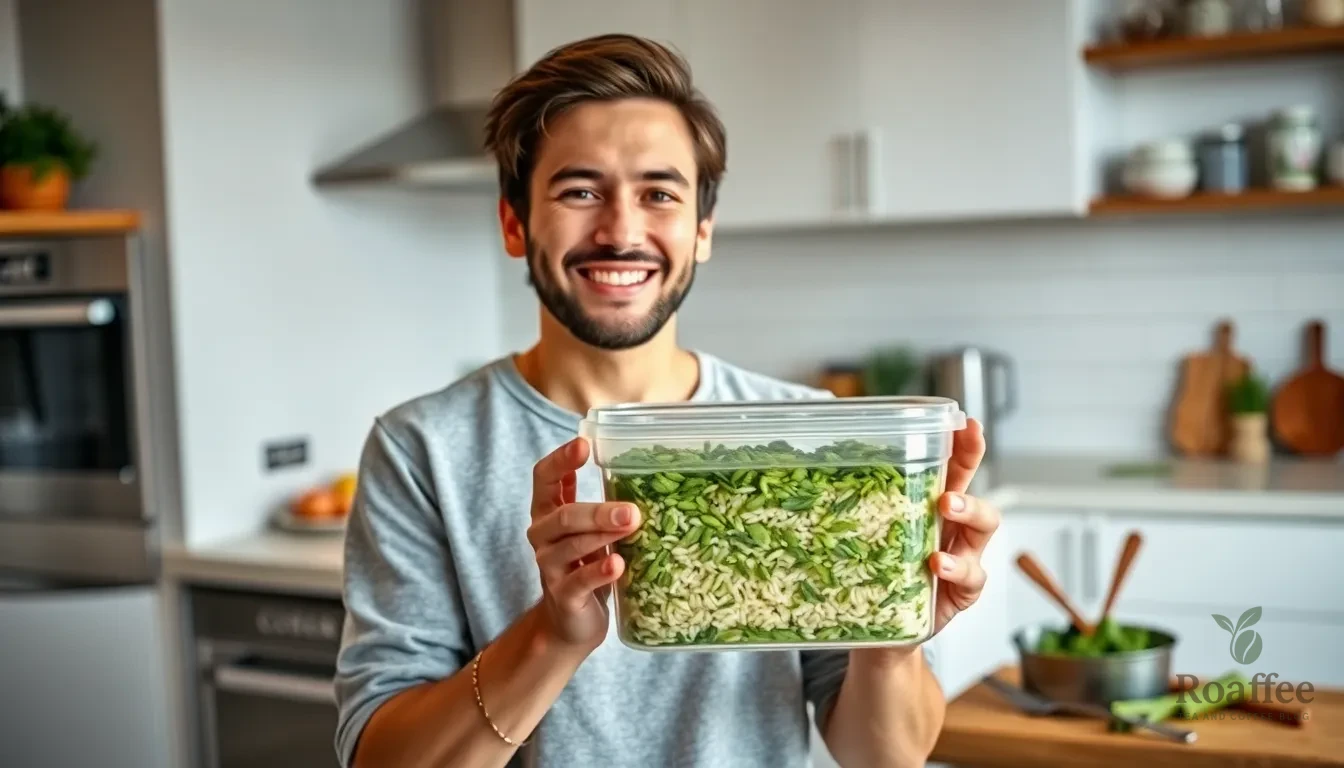
Proper storage keeps our green tea rice fresh and flavorful for several days. Following these guidelines ensures we can enjoy this aromatic dish throughout the week.
Refrigerator Storage
We recommend storing cooked green tea rice in an airtight container to maintain its freshness for up to 4-6 days. Sealing the container prevents the rice from drying out and absorbing unwanted odors from other foods in the refrigerator.
To preserve moisture during storage, we can place a damp paper towel over the rice before sealing the container. Alternatively, mixing the rice with a small amount of neutral oil before refrigerating helps maintain its texture and prevents grains from sticking together.
We should refrigerate our green tea rice within two hours of cooking to prevent bacterial growth and ensure food safety. This timing is crucial for maintaining both quality and safety standards.
Reheating Instructions
Gentle reheating preserves the delicate flavor and texture of our green tea rice. We recommend using a skillet or saucepan over medium heat, stirring frequently to prevent sticking or burning.
Adding a splash of water or broth during reheating helps restore moisture to the rice. This technique prevents the grains from becoming dry or tough during the warming process.
For microwave reheating, we place the rice in a covered container with a small amount of water to create steam. This method ensures even heating while maintaining the rice’s original texture and flavor profile.
We should avoid overheating the rice to prevent it from drying out or developing an unpleasant texture. Gentle warming preserves the subtle green tea essence that makes this dish special.
Recipe Variations
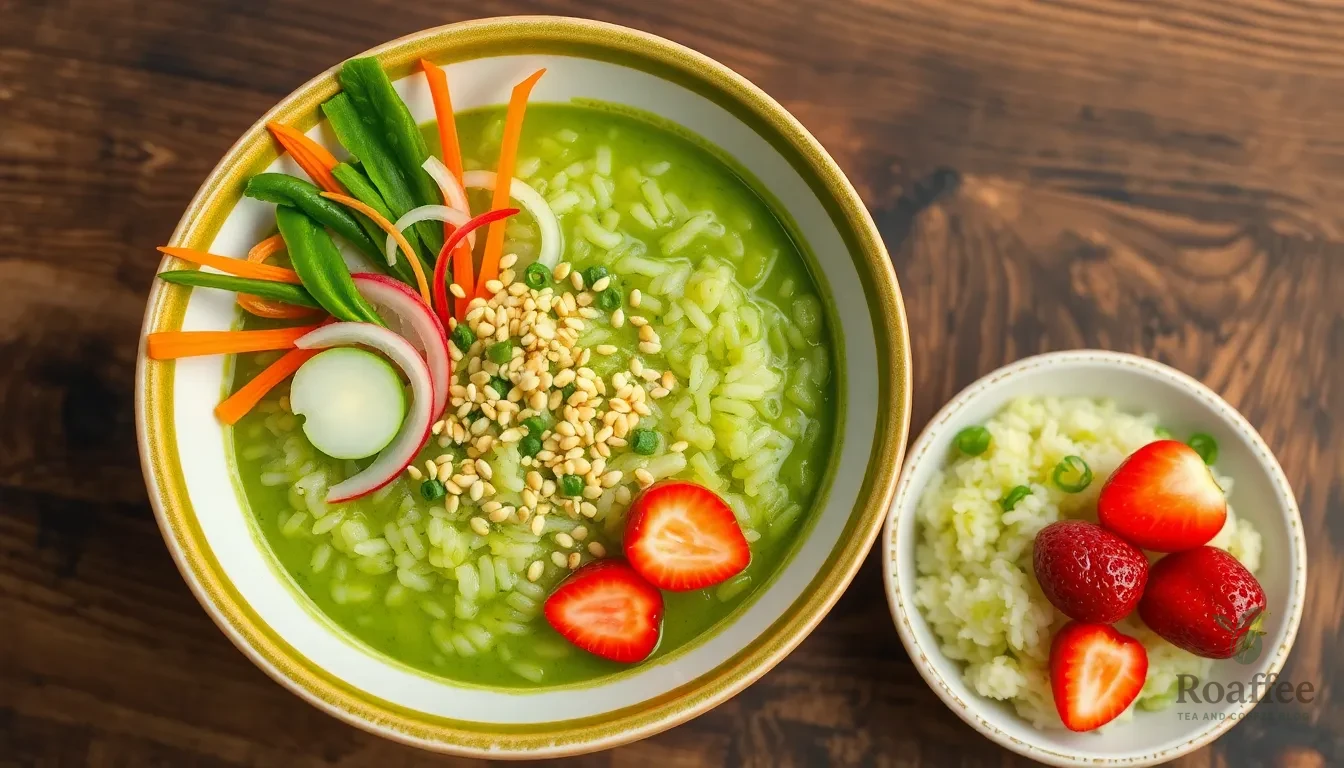
We can transform our basic green tea rice into exciting variations that showcase different flavors and textures. Each variation offers a unique twist on the traditional preparation while maintaining the essence of green tea.
Matcha Green Tea Rice
We create this vibrant version by whisking matcha powder directly into our cooking water instead of steeping tea leaves. Start with 2 tablespoons of culinary-grade matcha powder dissolved in 2 cups of water until smooth and lump-free. Cook 1 cup of rice in this matcha-infused water following our standard rice cooking method. The result delivers a striking green color and a stronger earthy flavor profile with subtle bitter notes that complement the rice’s natural sweetness. This variation works exceptionally well as a base for sushi bowls or paired with delicate fish dishes.
Green Tea Rice with Vegetables
We elevate our basic green tea rice by transforming it into a nutritious stir-fry that combines tea flavor with vegetable richness. Cook 1 cup of rice in brewed green tea as outlined in our base recipe and let it cool completely. Heat 2 tablespoons of sesame oil in a large skillet and sauté 1 cup of mixed vegetables such as diced carrots, peas, and onions until tender. Add 1 teaspoon of garlic powder and 2 tablespoons of soy sauce to the vegetables. Stir in the cooled green tea rice and cook until heated through, about 3-4 minutes. This savory variation provides a complete meal with added umami depth and colorful presentation.
Sweet Green Tea Rice
We transform our green tea rice into a dessert or breakfast option by adding sweeteners and complementary toppings. Prepare our basic green tea rice and while still warm, gently fold in 2-3 tablespoons of sugar or honey to taste. The residual heat will dissolve the sweetener evenly throughout the rice. Top with traditional additions like sweetened azuki beans, toasted sesame seeds, or fresh fruit such as sliced strawberries or mango. This variation offers a mild sweetness that enhances rather than masks the delicate tea flavor, making it perfect for afternoon treats or morning meals.
Conclusion
Green tea rice transforms a simple grain into an aromatic culinary experience that’s both nutritious and visually stunning. We’ve shown you how this versatile dish can elevate your dining table whether you’re preparing an everyday meal or hosting a special gathering.
The beauty of this recipe lies in its simplicity and adaptability. From the classic preparation method to creative variations with matcha or vegetables you can customize it to match your taste preferences and dietary needs.
We encourage you to experiment with different toppings and serving styles to make this dish truly your own. With proper storage techniques and reheating methods you’ll be able to enjoy perfectly textured green tea rice whenever the craving strikes.
Frequently Asked Questions
What is green tea rice?
Green tea rice is a Japanese dish that combines ordinary steamed rice with green tea or matcha powder, creating an aromatic and visually appealing pale green-colored rice. It enhances regular rice with the earthy flavors of green tea while providing additional antioxidants and health benefits from the tea.
What ingredients do I need to make green tea rice?
You’ll need 2 cups of short-grain white rice, 2 tablespoons of culinary-grade matcha powder, water, salt, and optional ingredients like unsalted butter and mirin. Optional toppings include toasted sesame seeds, nori seaweed, green onions, furikake seasoning, edamame, pickled ginger, and fresh cilantro.
What kitchen equipment is required for green tea rice?
The basic equipment includes a rice cooker or heavy-bottomed pot, measuring cups, a small bowl for soaking tea leaves, a fine-mesh strainer for brewing, and a wooden spoon or rice paddle for mixing. Most home cooks already have these essential tools.
How do I prepare green tea rice?
Start by boiling water and steeping green tea leaves to create a flavorful infusion. Rinse the rice to remove excess starch, then cook it in the brewed green tea with salt and optional oil. After cooking, fluff the rice and serve hot with desired garnishes.
What type of tea works best for green tea rice?
Loose leaf green tea, particularly Shincha, provides the clearest flavor and best results. Cold steeping is recommended to avoid bitterness. Culinary-grade matcha powder is ideal for direct mixing into the cooking water for a more vibrant color and stronger flavor.
How should I store and reheat green tea rice?
Store cooked green tea rice in an airtight container in the refrigerator for up to 4-6 days. Use a damp paper towel or mix in neutral oil to preserve moisture. Reheat gently using a skillet or microwave with added water to restore moisture and maintain flavor.
What are some serving suggestions for green tea rice?
Green tea rice pairs well with grilled proteins like teriyaki chicken or miso-glazed salmon. It can be transformed into ochazuke (tea rice soup) or fried rice with vegetables. Creative toppings include grilled chicken, soft-boiled eggs, and pickled ginger for elevated flavor combinations.
Can I make variations of green tea rice?
Yes, popular variations include Matcha Green Tea Rice (using matcha powder directly), Green Tea Rice with Vegetables (adding sautéed mixed vegetables), and Sweet Green Tea Rice (adding sweeteners and toppings like azuki beans or fresh fruit for a dessert option).




















